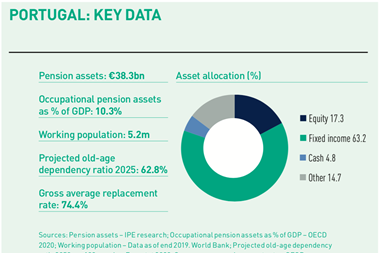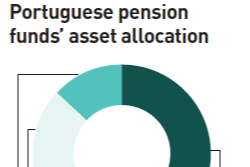Average gains of 3.8% in the final quarter of 2020 mean that Portuguese pension funds more than pulled back the ground lost following the first spate of COVID-19-linked lockdowns last March.
They returned an average 2.3% for the 12 months to 31 December 2020, compared with 8.2% for calendar year 2019.
The 2020 returns bring annualised three-year returns to 2.1% as at end-December 2020, with five-year returns of 2.2% to the same date, according to Willis Towers Watson (WTW). These compare with 1.1% and 1.8% for the annualised three- and five-year returns, respectively, to end-September 2020.
“Equity returns in Q4 were very strong, with various markets returning double digits,” said Jose Marques, director, retirement at WTW. “Corporate and government bond returns, especially securities with long durations, were also positive as a result of falling interest rates.”
Marques observed that Q2 was the strongest quarter of the year for most asset classes, with equity markets achieving one of the fastest-ever recoveries from a bear market, following the events of March 2020.
Portuguese pension funds recorded modest positive returns in Q3 and again in Q4, he said.
Performance figures were submitted to WTW by around 75% of the pension funds in Portugal, the overwhelming majority of them occupational funds.
Marques said the best-performing equity markets in 2020 were the US, especially tech companies, and emerging markets, despite the very large declines in the first quarter. Government bond returns were also high, with long-term European government bonds returning double digits.
But Marques said: “European equities have not fully recovered from the first quarter, delivering slightly negative returns. This had a negative impact on Portuguese pension funds, which still have some overweight to European equity.”
“We are seeing a slight increase in the amount of return-seeking assets in client strategic allocations”
Jose Marques, director, retirement at WTW
At the end of December 2020, equities made up 18% and real estate 11% of Portuguese pension fund portfolios, according to data from regulator ASF and from the Association of Investment Funds, Pension Funds and Asset Management.
However, the lion’s share of assets – 63% – was in debt, the same as in December 2019. Half this allocation was direct holdings in government debt.
Marques said: “We are seeing a slight increase in the amount of return-seeking assets in client strategic allocations. This change is a result of the need to generate return, which is now harder to find in fixed income.”
Marques said that over 2020, there was a “huge” amount of interest in hedging interest rate risk.
He pointed out that with funding levels highly susceptible to changes in interest rates, hedging the risk means structuring bond portfolios with longer durations to offset the liability exposures.
“This is something that few Portuguese pension funds were thinking about three years ago, but have recently started implementing,” he said.
“Some of the pension funds which put in place these hedging strategies enjoyed much higher than average returns in 2020, and more importantly, protected their funding positions from the falls in interest rates experienced over the year.”










No comments yet